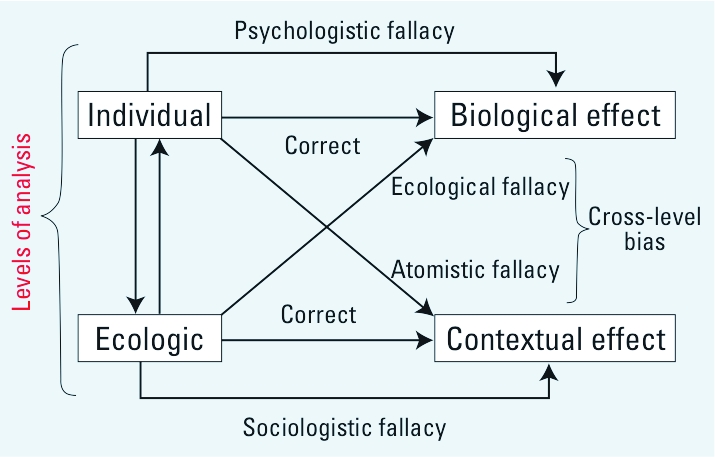In a large cohort study published in Environmental Health Perspectives, Brenner et al. (2011) confirmed previous results on I-131 exposure and thyroid cancer among a Ukranian population. According to the authors, one motivation to study this association was based on evidence from ecological studies (Jacob et al. 1999) with two methodological limitations: use of grouped doses and poor control of confounding. With these new findings, evidence from ecological, case–control, and cohort studies are consistent; thus, an interesting question is whether there was an ecological fallacy.
Although ecological studies are important to epidemiology (especially in environmental and social epidemiology), public health practitioners seem afraid of ecological studies. It is a common practice to assume the presence of ecological fallacy (Robinson 1950) and low-level validity when analyzing an ecological study. Most epidemiologists prefer an exclusive individualistic approach, although the importance of a multilevel causal approach is widely recognized (Diez-Roux 2002). In this sense, some authors suggest that it is as important to recognize the presence of ecological fallacy as to recognize psychologistic or individualistic fallacy (Subramanian et al. 2009) (Figure 1).
Figure 1.

Levels of analysys in epidemiologic studies and potential fallacies during casual inference.
Thus, it is necessary to have clear guidelines on when there is or not an ecological fallacy. In this sense, I propose three criteria for the identification of ecological fallacy; all three of these should be present to confirm its existence:
Results must be obtained with ecological (population) data.
Data must be inferred to individuals. One use of ecological studies is to explore individual-level association when individual data are not available. When the focus of the study was contextual or based on population effects and there is no inference to individuals, ecological fallacy is not possible. When only the first two criteria are present—which is insufficient to affirm ecological fallacy—it is appropriate to acknowledge that there is a possible relationship and that further study is required.
Results obtained with individual data are contradictory.
Only when empirical data are available is it possible to confirm that an ecological fallacy is present.
Footnotes
The author declares that he has no competing financial interests.
References
- Brenner AV, Tronko MD, Hatch M, Bogdanova TI, Oliynik VA, Lubin JH, et al. 2011I-131 dose response for incident thyroid cancers in Ukraine related to the Chornobyl accident. Environ Health Perspect 119933–939.; doi: 10.1289/ehp.1002674[Online 17 March 2011] [DOI] [PMC free article] [PubMed] [Google Scholar]
- Diez-Roux AV. A glossary for multilevel analysis. J Epidemiol Community Health. 2002;56(8):588–594. doi: 10.1136/jech.56.8.588. [DOI] [PMC free article] [PubMed] [Google Scholar]
- Jacob P, Kenigsberg Y, Zvonova I, Goulko G, Buglova E, Heidenreich WF, et al. Childhood exposure due to the Chernobyl accident and thyroid cancer risk in contaminated areas of Belarus and Russia. Br J Cancer. 1999;80(9):1461–1469. doi: 10.1038/sj.bjc.6690545. [DOI] [PMC free article] [PubMed] [Google Scholar]
- Robinson WS. Ecological correlations and the behavior of individuals. Am Sociol Rev. 1950;15(3):351–357. [Google Scholar]
- Subramanian SV, Jones K, Kaddour A, Krieger N. Revisiting Robinson: the perils of individualistic and ecologic fallacy. Int J Epidemiol. 2009;38(2):342–360. doi: 10.1093/ije/dyn359. [DOI] [PMC free article] [PubMed] [Google Scholar]


